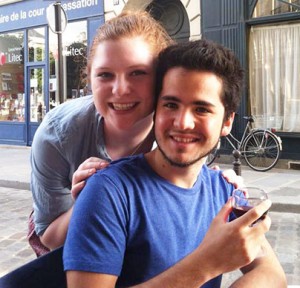Student Spotlight: Could You Repeat That? and Other Stories from Paris
Editor’s Note: Clare Brennan is a junior at the University of Michigan. This past summer she interned for ANRAT, a theater research company in Paris co-founded by Emmanuel Demarcy-Mota, director at Théàtre de la Ville. Their production of Pirandello’s Six Characters in Search of an Author comes to UMS October 24th and 25th.
The summer of 2014 consisted mainly of getting lost. As a first-timer to the grand city of Paris, or to any sort of international travel for that matter, I had incessantly practiced the correct way to ask for directions to the bus stop during my entire eight hour flight. Before I could get a “Bonjour” in edgewise, a bored flight attendant directed me towards my destination in perfect English, and I was on my way.
I’d gladly forget my first trek from the airport to the dorms, dragging my two oversized suitcases across town, but after the jetlag wore off, I started to get the hang of things. I became a lover of maps, discovering the metro system as quickly as possible. That knowledge invariably went out the window as soon as summer construction began. Eventually, I started ending up in the same places, and what was once a completely strange conglomerate of streets started feeling a little more like home.
Once settled in, I dove into the incredible wealth of theater surrounding me. With over 150 professional theaters within its city limits, Paris never let quantity deteriorate quality. One of my first shows was Ionesco’s Rhinocéros at Théàtre de la Ville. I had missed the production when it came to UMS last season, and was so excited when fellow UMS intern Flores Komatsu offered up a ticket to join him. We met at the theater and crossed one of the many bridges that connect the vastly different banks of the river to find a small café for dinner. A group of men of various ages played pétanque, the French equivalent of bocci ball, on a dirt patch next to us, a common pastime on summer evenings. Obviously American, we prattled away, catching up on upcoming projects, book recommendations, and travel plans. Eventually, the couple from Colorado sitting next to us struck up a conversation, and after twenty minutes we had learned the story of their ex-pat daughter and swapped recipes for favorite dishes we’ve discovered. Caught up in conversation, we barely realized we were running dangerously close to curtain time. We sprinted back to the theater and found our seats with just enough time to absorb the atmosphere.
*
I love theaters. Between their velvet curtains and cushioned seats, both actor and audience member gain some security to suspend their disbelief for a while and hear a story. I appreciate that sense of trust that seems built into the walls, and I always try and find it again before every show I see.
At Théàtre de la Ville, the most striking quality I found was its size, housing around 1,500. Our Monday evening show was sold out, and as I looked around, I noticed that most of those in attendance were around my age. In my exploration of the arts at home, I’ve often found truly invested younger patrons more difficult to find. There, young people come to shows, stay for talkbacks, and attend season premieres; Théàtre de la Ville’s season announcement, for instance, packed the house just as tightly as their best-known runs.

Photo: Le Palais de Pape, where “I Am” played during the Avignon Theater Festival in July. Photo by Clare Brennan
The house lights dimmed, and I experienced again what would quickly become one of my favorite culture moments abroad. Before an actor ever sets foot on stage, a score of audience members will audibly shush one another. It will be hard to forget my first experience of this sort, as the majority of hisses were directed at me. Foreign air and a lack of sleep had left me sick for a couple weeks, and, apparently, I thought that the start of the Moroccan acrobatic performance Azimut at Théàtre du Rond Point would be a lovely time for a coughing fit; the surrounding patrons did not. I quickly picked up this less-than-subtle social cue, and by the end of my two months, I was joining in as passive-aggressively as possible. Strong reactions like this were never out of place. At the Avignon Theater Festival, a production of Lemi Ponifasio’s I Am, a World War II homage in dance, produced critical laughter, side comments, even a small exodus after a particularly difficult movement. However, with this piece included, I also never saw a performance without at least five minutes of applause at the close.
*
Seeing theater in a foreign language took a bit of adjustment. Rhinocéros opens with a beautiful monologue. I couldn’t tell you what the first few lines mean now, as I was still looking for surtitles within the first few moments before I remembered where I was. I did have opportunities to try reading French surtitles during a Dutch production of Ayn Rand’s The Fountainhead and a Japanese kabuki style of the Mahabharata. Reading and translating French while listening to another language with which I had no experience left my American brain a little withered, but it did help me to abandon any pretenses I had when I arrived and dedicate a couple of hours to a completely new experience. Or four and a half hours, in the case of the Dutch Fountainhead. (I have to admit, I dozed off for about twenty minutes of that. I read the book in high school, so that counts, right?)
That night, Flores and I left the theater and lingered on the rainy sidewalk with a crowd of theatergoers doing the same. We all shared our thoughts, compared interpretations, raved over actors, and tried to weave our way through the denser moments. We said our goodbyes for the night, and as I turned to leave, I realized that I was pretty disoriented. I was lost in Paris again, but what else was new. Theater abroad left me dizzy and buzzing, not quite sure of where I stood but happy that I was there. I was used to the feeling by now, and there could be worse places to get turned around. Paris is a city for wandering, anyway.







